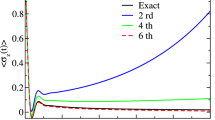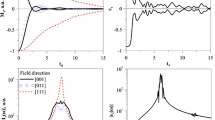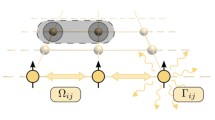Abstract
In this paper, a formalism for studying the dynamics of quantum systems coupled to classical spin environments is reviewed. The theory is based on generalized antisymmetric brackets and naturally predicts open-path off-diagonal geometric phases in the evolution of the density matrix. It is shown that such geometric phases must also be considered in the quantum–classical Liouville equation for a classical bath with canonical phase space coordinates; this occurs whenever the adiabatics basis is complex (as in the case of a magnetic field coupled to the quantum subsystem). When the quantum subsystem is weakly coupled to the spin environment, non-adiabatic transitions can be neglected and one can construct an effective non-Markovian computer simulation scheme for open quantum system dynamics in classical spin environments. In order to tackle this case, integration algorithms based on the symmetric Trotter factorization of the classical-like spin propagator are derived. Such algorithms are applied to a model comprising a quantum two-level system coupled to a single classical spin in an external magnetic field. Starting from an excited state, the population difference and the coherences of this two-state model are simulated in time while the dynamics of the classical spin is monitored in detail. It is the author’s opinion that the numerical evidence provided in this paper is a first step toward developing the simulation of quantum dynamics in classical spin environments into an effective tool. In turn, the ability to simulate such a dynamics can have a positive impact on various fields, among which, for example, nanoscience.




Similar content being viewed by others
References
Kapral R, Sergi A (2005) Dynamics of condensed phase proton and electron transfer processes, vol. 1, ch. 92. In: Rieth M, Schommers W (eds) Handbook of theoretical and computational nanotechnology. American Scientific Publishers, Valencia, CA
Likharev KK (1996) Dynamics of Josephson junctions and circuits. CRC Press, Amsterdam
Hayashi T, Fujisawa T, Cheong HD, Jeong YH, Hirayama Y (2003) Coherent manipulation of electronic states in a double quantum dot. Phys Rev Lett 91:226804
Petta JR, Johnson AC, Marcus CM, Hanson MP, Gossard AC (2004) Manipulation of a single charge in a double quantum dot. Phys Rev Lett 93:186802
Petta JR, Johnson AC, Taylor JM, Laird EA, Yacoby A, Lukin MD, Marcus CM, Hanson MP, Gossard AC (2005) Coherent manipulation of coupled electron spins in semiconductor quantum dots. Science 309:2180–2184
Leggett AJ, Chakravarty S, Dorsey AT, Fisher MPA, Garg A, Zwerger W (1987) Dynamics of the dissipative two-state system. Rev Mod Phys 59:1–85
Prokof’ev NV, Stamp PCE (2000) Theory of the spin bath. Rep Prog Phys 63:669–726
Breuer H-P, Petruccione F (2002) The theory of open quantum systems. Oxford University Press, Oxford
Ottinger HC (2005) Beyond equilibrium thermodynamics. Wiley, Hoboken
Ottinger HC (2000) Derivation of a two-generator framework of nonequilibrium thermodynamics for quantum system. Phys Rev E 62:4720
Ottinger HC (2010) Nonlinear thermodynamic quantum master equation: properties and examples. Phys Rev A 82:052119
Ottinger HC (2011) Euro Phys. Lett. 94:10006
Ottinger HC (2012) Stochastic process behind nonlinear thermodynamic quantum master equation. I. Mean-field construction. Phys Rev A 86:032101
Flakowski J, Schweizer M, Ottinger HC (2012) Stochastic process behind nonlinear thermodynamic quantum master equation. II. Simulation. Phys Rev A 86:032102
Sergi A (2013) Communication: quantum dynamics in classical spin baths. J Chem Phys 139:031101
Anderson A (1995) Quantum backreaction on “classical” variables. Phys Rev Lett 74:621–625
Prezhdo O, Kisil VV (1997) Mixing quantum and classical mechanics. Phys Rev A 56:162–176
Zhang WY, Balescu R (1988) Statistical mechanics of a spin polarized plasma. J Plasma Phys 40:199–213
Balescu R, Zhang WY (1988) Kinetic equation, spin hydrodynamics and collisional depolarization rate in a spin-polarized plasma. J Plasma Phys 40:215–234
Osborn TA, Kondrat’eva MF, Tabisz GC, McQuarrie BR (1999) Mixed Weyl symbol calculus and spectral line shape theory. J Phys A 32:4149–4169
Gerasimenko VI (1982) Dynamical equations of quantum–classical systems. Teoret Mat Fiz 50:77–87
Boucher W, Traschen J (1988) Semiclassical physics and quantum fluctuations. Phys Rev D 37:3522–3532
Martens CC, Fang J-Y (1996) Semiclassical limit molecular dynamics on multiple electronic surfaces. J Chem Phys 106:4918–4930
Kapral R, Ciccotti G (1999) Mixed quantum–classical dynamics. J Chem Phys 110:8919–8929
Horenko I, Salzmann C, Schmidt B, Schutte C (2002) Quantum–classical Liouville approach to molecular dynamics: surface hopping gaussian phase-space packets. J Chem Phys 117:11075–11088
Shi Q, Geva E (2004) A derivation of the mixed quantum–classical liouville equation from the influence functional formalism. J Chem Phys 121:3393–3404
Sergi A, Sinayskiy I, Petruccione F (2009) Numerical and analytical approach to the quantum dynamics of two coupled spins in bosonic baths. Phys Rev A 80:012108
Allen MP, Tildesley DJ (2009) Computer simulation of liquids. Oxford University Press, Oxford
Frenkel D, Smit B (2002) Understanding molecular simulation. Academic Press, London
Sergi A (2005) Non-Hamiltonian commutators in quantum mechanics. Phys Rev E 72:066125
Sergi A (2007) Deterministic constant-temperature dynamics for dissipative quantum systems. J Phys A: Math Theor 40:F347–F354
Sergi A (2006) Statistical mechanics of quantum–classical systems with holonomic constraints. J Chem Phys 124:024110
Sergi A, Ferrario M (2001) Non-Hamiltonian equations of motion with a conserved energy. Phys Rev E 64:056125
Sergi A (2003) Non-Hamiltonian equilibrium statistical mechanics. Phys Rev E 67:021101
Sergi A, Giaquinta PV (2007) On the geometry and entropy of non-Hamiltonian phase space. J Stat Mech Theory Exp 02:P02013
Sergi A (2004) Generalized bracket formulation of constrained dynamics in phase space. Phys Rev E 69:021109
Sergi A (2005) Phase space flows for non-Hamiltonian systems with constraints. Phys Rev E 72:031104
de Polavieja GG, Sjöqvist E (1998) Extending the quantal adiabatic theorem: geometry of noncyclic motion. Am J Phys 66:431–438
Mead CA, Truhlar DG (1979) On the determination of born-oppenheimer nuclear motion wave functions including complications due to conical intersections and identical nuclei. J Chem Phys 70:2284–2296
Berry MV (1984) Quantal phase factors accompanying adiabatic changes. Proc R Soc Lond Ser A 392:45–57
Shapere A, Wilczek F (eds) (1989) Geometric phases in physics. World Scientific, Singapore
Mead CA (1992) The geometric phase in molecular systems. Rev Mod Phys 64:51–85
Kuratsuji H, Iida S (1985) Effective action for adiabatic process. Prog Theor Phys 74:439–445
Tuckerman M, Martyna GJ, Berne BJ (1992) Reversible multiple time scale molecular dynamics. J Chem Phys 97:1990–2001
Martyna GJ, Tuckerman M, Tobias DJ, Klein ML (1996) Explicit reversible integrators for extended systems dynamics. Mol Phys 87:1117–1157
Sergi A, Ferrario M, Costa D (1999) Reversible integrators for basic extended system molecular dynamics. Mol Phys 97:825–832
Ezra GS (2006) Reversible measure-preserving integrators for non-Hamiltonian systems. J Chem Phys 125:034104
Sergi A, Ezra GS (2010) Bulgac-Kusnezov-Nose-Hoover thermostats. Phys Rev E 81:036705
Sergi A, Ezra GS, Bulgac–Kusnezov–Nosé-Hoover thermostats for spins, unpublished
Nielsen S, Kapral R, Ciccotti G (2001) Statistical mechanics of quantum–classical systems. J Chem Phys 115:5805–5815
Sergi A, Giaquinta PV (2007) On computational strategies in molecular dynamics simulation. Phys Essays 20:629–640
Pati AK (1998) Adiabatic berry phase and Hannay angle for open paths. Ann Phys 270:178–197
Filipp S, Sjöqvist E (2003) Off-diagonal generalization of the mixed-state geometric phase. Phys Rev A 68:042112
Englman R, Yahalom A, Baer M (2000) The open path phase for degenerate and non-degenerate systems and its relation to the wave function and its modulus. Eur Phys J D 8:1–7
Manini N, Pistolesi F (2000) Off-diagonal geometric phases. Phys Rev Lett 85:3067–3071
Frank J, Huang W (1997) Leimkuhler geometric integrators for classical spin systems. J Comput Phys 133:160–172
Krech M, Bunker A, Landau DP (1998) Fast spin dynamics algorithms for classical spin systems. Comput Phys Commun 111:1–13
Steinigeweg R, Schmidt H-J (2006) Symplectic integrators for classical spin systems comput. Phys Commun 174:853–861
Yoshida H (1990) Construction of higher order symplectic integrators. Phys Lett A 150:262–268
Acknowledgments
The author is grateful to G. S. Ezra for many discussions, encouragement and support received in the past few years.
Author information
Authors and Affiliations
Corresponding author
Additional information
Dedicated to Professor Greg Ezra and published as part of the special collection of articles celebrating his 60th birthday.
This work is based upon research supported by the National Research Foundation of South Africa.
Appendices
Appendix 1: Integration algorithm on the (1, 1) surface
In pseudo-code form, the algorithm provided by \(U_{(1,1)}^1(\tau )\) is:
The algorithm provided by \(U_{(1,1)}^2(\tau )\) is:
The algorithm provided by \(U_{(1,1)}^3(\tau )\) is:
Appendix 2: Integration algorithm on the (2, 2) surface
The algorithm provided by \(U_{(2,2)}^1(\tau )\) is
The algorithm provided by \(U_{(2,2)}^2(\tau )\) is
The algorithm provided by \(U_{(2,2)}^3(\tau )\) is
Appendix 3: Integration algorithm on the \((1,2)\) surface
The algorithm provided by \(U_{(1,2)}^1(\tau )\) is
The algorithm provided by \(U_{(1,2)}^2(\tau )\) is
Rights and permissions
About this article
Cite this article
Sergi, A. Computer simulation of quantum dynamics in a classical spin environment. Theor Chem Acc 133, 1495 (2014). https://doi.org/10.1007/s00214-014-1495-4
Received:
Accepted:
Published:
DOI: https://doi.org/10.1007/s00214-014-1495-4




